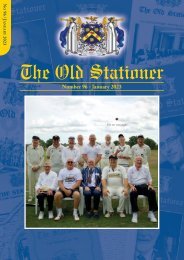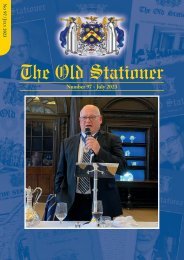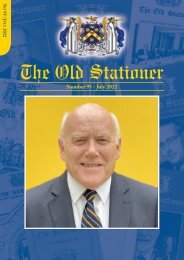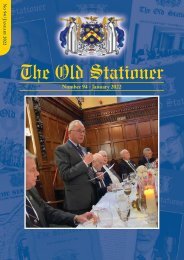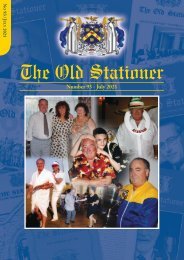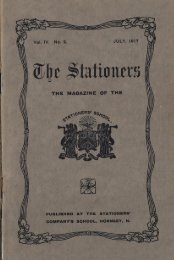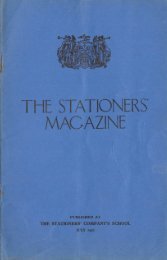Create successful ePaper yourself
Turn your PDF publications into a flip-book with our unique Google optimized e-Paper software.
T h e O l d S t a t i o n e r - N o 7 8<br />
in finding out about their families. One of the<br />
more recent requests was by Nic Sansom for<br />
details of his father John Frank Sansom born<br />
in 1926 and therefore arrived at Stationers'<br />
circa 1937. In recent time our archivist David<br />
Turner has been busy answering queries of<br />
such a kind.<br />
The magazines that exist from about 1914 to<br />
about 1954 have been almost continuous,<br />
even termly, in including a section on<br />
'Welcome' and 'Farewell' even during wartime<br />
apart from the odd issue in 1939-1942.<br />
However, some bright spark on the editorial<br />
board, circa 1955, decided that the list of new<br />
pupils was not important and decided not to<br />
include them. Perusing the December<br />
magazines from 1955 to 1960 there is not one<br />
list of pupils for the new entry in the September<br />
of those years, a tradition that had been<br />
always a significant part of the magazines for<br />
over forty years!<br />
Shame on that misguided individual or was it<br />
a collective decision; but an individual must<br />
have proposed the idea!!<br />
Finding out a quick answer as to when a<br />
former pupil was at Stationers', the 'Welcome'<br />
and 'Farewell' lists were, and still are the most<br />
used and therefore the most important parts<br />
of the magazines. Only recently we had a<br />
request for information by C.J.Kershaw about<br />
his father J.B.Kershaw, born on 12.8.1900.<br />
Well, it is not too difficult to work out that<br />
CJK joined Stationers' in 1911 or thereabouts<br />
and left in about 1916. No magazines<br />
available till 1914, but except for the<br />
'Welcome' list they would not have been<br />
significant in tracking down this lad.<br />
However, if any Stationer excelled at sport,<br />
football, athletics, cricket or swimming and or<br />
if not, appeared on an academic list<br />
particularly in the fourth and fifth years, not<br />
too many stayed on to the sixth in those days,<br />
their names are etched on the hallowed pages<br />
of the School Magazine. Such is the case of<br />
John Brian Kershaw, who had an illustrious<br />
career in the field of sport, who was 'Victor<br />
Ludorum' obviously excelling in athletics in<br />
his time at Stationers', and a first eleven<br />
footballer. There are many references to him in<br />
magazines of 1915 and 1916. “I have the<br />
plaque exactly as the stained glass shown on<br />
your website, so I know he went to Stationers'.<br />
The plaque is for 'SPORTS Championship<br />
1916 J.B.KERSHAW'. I will photograph the<br />
plaque'. Are there any pupil records available<br />
of J.B.Kershaw?” Regards C.J.Kershaw. Ed.<br />
TWo oLD STATioNERS' FAMiLiES uNiTED... BY MARRiAGE!<br />
In what is not without precedent (*see footnote), the families of<br />
Old Stationers John Macara (1928-1938) and Andrew Forrow<br />
(1960-1967) were this year brought together by the marriage of<br />
John's granddaughter, Beccy, and Andy's son, Duncan. The<br />
wedding took place in a civil ceremony conducted at Devonshire<br />
Square in the City of London on September 14th2013. For those<br />
who know the City, the venue is one of many restored warehouse<br />
buildings to be found, down New Street or Cutler Street,<br />
between Liverpool Street station on Bishopsgate and the historic<br />
Spitalfields Market.<br />
The Wedding Venue<br />
Devonshire Square has fascinating history. In 1768, the East<br />
India Company bought land on New Street for warehousing. Its<br />
first building stored raw silk, piece goods and textiles from<br />
Bengal. Further parcels of land were acquired and more<br />
warehouses constructed right up until 1820. By then, the famous<br />
old trading company owned most of the area and property that<br />
the Devonshire Square Estate occupies today.<br />
When the East India Company's trade monopoly to China<br />
ended in the 1830s, the complex of warehouses was sold to the<br />
St Katharine Dock Company.<br />
The most valuable goods were stashed in the Cutler Street<br />
warehouses, where the forbidding fortress-like walls and the<br />
fireproof construction afforded excellent protection. Ostrich<br />
feathers, chinaware, oriental carpets, cigars, tortoiseshell, silks,<br />
mother of pearl, clocks, watches, cameras, drugs, spices, musical<br />
instruments, perfumes, tea and other-prized artefacts were stored<br />
here. (All sorts of useful commodities for Old Stationers'<br />
gatherings we expect)<br />
At one time, Cutler Street was the premier tea warehouse for the<br />
Port of London Authority. But by the 1950s, most of the tea<br />
business had been moved to the London Dock, and the space<br />
was given over to casks of wine, port and sherry. (Again, highly<br />
regarded by most Old Stationers!)<br />
The Happy Couple<br />
The lovely Bride was born in Buckinghamshire and attended<br />
Chesham High School for Girls before enjoying her University<br />
education at the University of Sheffield. Her Degree has led her<br />
to her current position as Research Manager for a leading<br />
educational charity, the Hansard Society, which works in the UK<br />
and around the world to promote democracy and strengthen'<br />
parliaments. This is where Beccy organises events and projects to<br />
increase the understanding of political institutions, especially<br />
among young people.<br />
27



